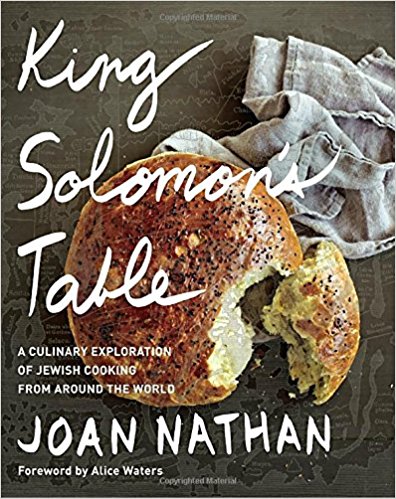First is Joan Nathan’s eleventh Jewish cookbook. Just in time for Passover
The cover tells the story: a variation of a challah roll (and EThiopian sabbath bread) lying atop an embossed map of the nations of the world. Joan Nathan, a tireless, curious, multilingual cookbook goddess, was in the Paradesi Synagogue in Kochi, Kerala, India, researching a book when she noted a sign that said Jewish people had been in India since the time of King Solomon. Whether it is myth, legend, or fact, she pondered how so many Jewish merchant seamen and traders traveled from the Middle East to other ports for business, spices, and spouses; and they created relationships and families, and “mashed-up” their Jewish food traditions with local customs, foodways and ingredients. She changed her plans and wrote this cookbook, her eleventh, instead.
In it, Ms. Nathan travels – like these ancient mariners – from country to country, and finds she Jewish mash-ups, whether it is Jewish foods from Europe that ended up in Dayton, or Turkish staples in Cuba, or the foods of Babylonia in FSU Georgia. As she once said, “When I lived in Israel, I saw not a clash but a coming together of civilizations. You know, for me, Jewish food was my mother’s matzoh ball soup. Then I went there and I saw stuffed vegetables and all kinds of salads that were different… I realized then that food was culture, and it was not restaurant culture. It was ethnic culture.”
The title? It is said that Solomon had 700 wives and half as many girlfriends, and they had many food traditions. He learned from them, they learned from him, and there was a sharing of recipes and other things. It was “tabletop Judaism.” In this spirit, Nathan shares over 170 uniquely Jewish recipes from El Salvador to Israel, from Morocco to Cuba, Siberia to Canada, and Sri Lanka (you know the Rambam’s brother lived there…) to Romania.
The book opens with a quote from Genesis: When woman ate of the tree of wisdom, she took of its fruit and ate, and shared some with her husband, and he ate. This is followed by a 16 page introduction to Solomon, Babylon, Judea, and the roots of Jewish foods; and 11 pages on pantry spices. There are sections for Morning (16 recipes); Starters (21 recipes), Salads (16 recipes), Soups and Their Dumplings (13 recipes), Breads (7 Sabbath breads, 4 Weekday breads), Grains and Such (10 recipes), Vegetables (15), Fish (15), Poultry (10), Meat (14), and Sweets (23).
The aleph recipe is an Azerbaijani Kukusa with Swiss Chard and Herbs, which is easy and herb-infused and a living vestige of Jewish life in Babylonia and Persia and an example of how a Jewish dish traveled from southern France to North Africa and back to France, morphed to Azerbaijan and then to Brooklyn. The Tof “closing recipe” is a Libyan Saefra, King Solomon Cake (how often have you used Cream of Wheat and Orange zest in a recipe?).
One of the fascinating aspects of this book is that each recipe has a priceless shared story and an amazing photo. To me, it is a keepsake. Smoky Shakshuka with Tomatoes, Peppers, and Eggplant comes with a story of colonial Williamsburg and its first Jewish resident, Dr. de Sequeyra, who introduced tomato-eating to his neighbors and patients. A Matzo Brei recipe comes with a cook-off story than ranges from Zamosc Poland to DC to the residence of the late Sheila Lukins (author of Silver Palate Cookbook). A recipe for Chilaquiles (Mexican Matzo Brei) is delivered with a story from LA’s Jonathan Gold. Her “New Old Fashioned Bagel” recipe is akin to Montreal style ones of Mark Furstenberg’s “Bread Furst.” Speaking of Canada, there is a recipe for Toronto-style Shtritzlach, as well as Siberian Chremsel. The Socca (chickpea pancake) recipe may change your life, as will Caponata Siciliana di Melanzane alla Giudia (many say that the Jews introduced eggplants to Sicily). Her Hummus with Preserved Lemon and Cumin recipe is matched with a Hebrew translation story on whether it was ‘vinegar’ or ‘hummus’ that Boaz served his workers in The Book of Ruth.
Other highlights (just mentioning a few) include: Corfu/Italian Huevos Haminados con Spinaci (Long-Cooked Eggs with Spinach) from Daisy Dente Modigliani; Halleq (Persian Haroset); Ferrara Haroset (using banana, pear, and apple); Bene Israel Fish Curry with Fresh Ginger, Tamarind, and Cilantro (from Babu of Ernakulam, India); Matbucha; Curried Beet Borscht with Apples and Ginger; Yemenite Chicken Soup with Dill, Cilantro and Parsley, Persian Cucumber and Radish Salad with Hungarian Paprika; Salonikan MelitzanoSalata; Tchav; Honduran/CrownHeights mashup Winter Squash Soup with Hot Pepper and Coconut Milk; Perugia-style Cod with Tomatoes, Dried Plums, Onions, and Pine Nuts; Abgoosht with Gundi; Suellen Lazarus’ Vegetarian Matzo Ball Soup with Ghee; Concia; T’beet (Baghdadi Sabbath Overight Spiced Chicken with Rice and Coconut Chutney); Karaite-style Spiced Fried Matzo with Celery Seed and Tumeric; Kosher-Brined Roast Turkey with Challah-Chestnut-Cranberry Stuffing; Bulgarian Pashtida (from Spain Greece, the Balkans); Kubbanah, Ka’ak; Pletzel; Parpikas Krumpli (Hungarian Roasted Potatoes with Onions); Fideos Tostados with Cinnamon-Spiked Tomato Sauce (coupled with an essay on Rabbi Mussana and his concordance to the 1140 CE HeAruch); Slightly Sweet and Sour Cabbage (via Cuba by way of Ladino speakers of Turkey); Hand Cured Corned Beef; Indian Chicken with Cardamom, Cumin and Cilantro; David Tanis’ Dayton, Ohio-inspired Poached Salmon with Ginger-Cilantro Butter and Spinach; Macedonian Leek and Meat Patties; Roman Ricotta Cheese Crostata with Cherries or Chocolate; and El Salvador Schokoladenwurst.
For those Solomon’s out there… take off the dist jacket and find two photos. Hummus. and a Crostata. Is there is hidden meaning? Did it all start in Sumer with Hummus?
Some recipes:
SALYANKA, GEORGIAN BEEF STEW WITH RED PEPPERS
As I first bit into this delicious Georgian beef stew, I was intrigued by the fact that, as with many early Jewish recipes I have found around the world, the beef, often a tough inexpensive cut, is first boiled in water until it is almost tender and then layered with flavor from onions, spices and bright red bell peppers. No browning the meat first for this recipe. After slowly simmering the beef for a few hours, you are rewarded with a melt-in-your-mouth, silky stew – a perfect main dish for Passover or any special occasion throughout the year.
2 pounds stewing beef, cut into 1 1/2-inch chunks
2 large red bell peppers (about 1 pound), cut into 1-inch squares
10 ounces high-quality canned plum tomatoes (or about 4 fresh plum tomatoes, peeled, crushed with your hands)
2 heaping tablespoons tomato paste
2 large onions, diced (2 cups)
5 cloves garlic, minced (2 tablespoons)
Salt and freshly ground pepper to taste
1/2 teaspoon hot paprika, or to taste
1/2 teaspoon sweet paprika, or to taste
1/2 bunch parsley, chopped and divided
Put the meat in a Dutch oven or similar heavy pot and cover with about 3 cups water. Bring to a boil, then lower the heat and simmer, uncovered, for 1 hour and 15 minutes or until almost tender, adding more water if necessary. You might have to periodically skim foam that accumulates on the top.
Add the red peppers and the tomatoes, stir, and cook uncovered for another 20 minutes.
Stir in the tomato paste, onions and garlic, reduce the heat to low, cover and cook for another 40 minutes to 1 hour, or until the beef is very tender and almost falling apart.
Season with salt, pepper, and hot and sweet paprika to taste and stir in half the parsley. Serve over rice or potatoes, sprinkled with the remaining parsley.
Yield: 6 to 8 servings
HALLEQ, PERSIAN HAROSET WITH DATES, APPLES, PISTACHIOS AND POMEGRANATE JUICE
Every Passover, I make about five kinds of haroset from different parts of the world. For me, the various blends, representing the mortar used to make bricks in slavery in ancient Egypt, reflect the regional dispersal of the Jews throughout history.
Haroset, a popular dipping sauce for feasts in Babylon, was brought to Jerusalem and later added to the Passover Seder after the destruction of the Second Temple. For centuries, the sauce, originally made of dates, was slowly cooked in copper pots, used to cook down the fruit into a syrupy honey, making the biblical date honey. Then it was topped with ground walnuts. Later, in Baghdad (about 30 miles from Babylon), it was traditional to buy the dates, press them through a special machine, letting the syrup ooze out, and then heat the dates very slowly in a copper pot until they were the thick consistency of a jam-like syrup. I have heard stories about men and women who would roam the streets of Baghdad hawking this date honey served with clotted cream on bread or matzo for breakfast.
As Jews settled on the Silk Road or throughout the Mediterranean, they either brought with them their recipe for haroset, if they could find all the ingredients, or created new ones, based on ingredients where they lived.
Egyptian haroset includes raisins, dates, and nuts, and Persian haroset, called halleq, is filled with nuts and dried fruits, pomegranate juice, bananas, and cardamom as the prominent spice, but uncooked.
1 cup almonds
1 cup roasted, shelled pistachios
1 cup walnuts
1 cup black raisins
1 cup golden raisins
1 cup dates, pitted
2 teaspoons cinnamon
2 teaspoons ground cardamom
1 teaspoon ground ginger
1/2 teaspoon ground nutmeg
1 large apple, peeled, cored, and quartered
1 large pear, peeled, cored, and quartered
2 bananas, peeled
2 to 3 tablespoons cider vinegar
1/2 to 1 cup pomegranate juice
1/2 to 1 cup sweet kosher wine
In a large food processor, combine the almonds, pistachios, walnuts, black and golden raisins, dates, cinnamon, cardamom, ginger and nutmeg. Pulse until the nuts are coarsely chopped.
Add the apple, pear, and bananas, then pulse until coarsely chopped. Add 2 tablespoons of the vinegar, 1/2 cup of the pomegranate juice, and 1/2 cup of the wine. Pulse again, adding more vinegar, juice or wine to taste or as needed to make a coarse paste. Do not purée; the mixture should retain some crunch.
Yield: 6 cups
MAINE HAROSET WITH BLUEBERRIES, CRANBERRIES AND GINGER
This recipe developed from a conversation years ago as Judy Stein and some friends in Belfast, Maine, tasted haroset variations from various places around the world. Together they concocted what has become their traditional Maine haroset, with blueberries, cranberries, and, as a nod to eastern European haroset, an apple. Haroset should resemble the mortar used to build the pyramids, so Judy felt that it should include something long and thin to resemble straw and added ginger (definitely not from Maine). The wine vinegar adds the bitter taste to remind us, as always, of the bitterness of the time in Egypt with the pharaohs.
3/4 cup dried blueberries
3/4 cup dried cranberries
3/4 to 1 cup sweet kosher wine
1 tart apple, diced and peeled
1/3 cup ginger, peeled and sliced into toothpick-size strips
1/3 cup golden raisins
1/4 cup wine vinegar
1/2 teaspoon ground cinnamon
2 tablespoons maple syrup or honey
Soak the dried blueberries and cranberries in 3/4 cup of the wine for several hours, or overnight, until soft.
Put the berry-wine mixture with the apple, ginger, raisins, wine vinegar, and cinnamon in a medium saucepan and cook over medium heat about 10 to 12 minutes, or until the apples are soft. Process in a food processor until combined, but not completely puréed. Add maple syrup or honey to taste and, if needed, 1/4 cup more wine.
Yields about 2 cups.
The recipes are excerpted from “King Solomon’s Table” by Joan Nathan. Copyright 2017 by Random House. Excerpted by permission of Alfred A. Knopf, a division of Random House LLC. They reserve all rights to this material. Do not reproduce or reprint any recipe without permission from the publisher.





